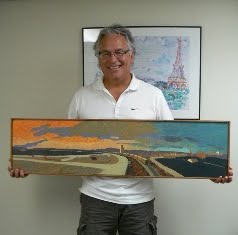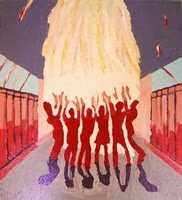Getting students up close and figure out for themselves what the artist was doing on a work. On November 16, 17, 18 and 19, my wife invited me to speak to her fifth and sixth grade art classes. Four days, eight classes, about fourteen
students to a class. The following are portions from one class period on Tuesday, Nov.17th. (Students are unnamed)
Double click on images.
Art teacher Mrs.
Marxhausen, Ms. Jan (MJ): He went to school to be an artist. He IS AN ARTIST. He doesn't make a living at it, but he has sold some artwork.
And he just wants to talk about his experience and give you a feel for
some of the ins and outs of what he does. So, be the nice, gentle, kind,
caring, respectful students that you are. I think it will be
interesting. Most everybody that has heard it has liked it. And he's
gotten better than he was yesterday.
Karl Marxhausen (KM): Okay.
My name is Mr. Marxhausen. But you can call me "Mister Jan." So I
brought some paintings today. I want to share some with you. Some of it
I'll be talking about. Some of it YOU will be talking about. So we have
an exercise here.
You can know a lot about an artist by looking at a piece. The artist always uses colors he or she wants to use.
KM: Does anybody see a bright splash of red in the middle of this painting?
Students: No.
KM: No, I wasn't interested in that. Is there a bright splash of white in the middle of the painting?
Students: No.
KM:
That's right. I wasn't interested in that color either. What I am going
to do is have you help me. We're going to start with this gentleman
here and I am going to ask different ones to come up. You will stand
over here (beside the painting on the easel) and I will tell you what to
do.
So, I want everyone to watch what he is doing. (First student walks up.)
KM: So stand here. Now point to
one color that you see in this painting.
(Student points to the shirt, see next)
KM:
Okay. He is pointing to the
blue here. Now I want you to take your time
and
point to all the places you see that same kind of blue on this
painting. (Student pointed to the following areas on painting. Some were low and some were way up high.)
KM:
Yes. You may have a seat. Good job. We are going to follow his example. I
need the person with the Red Sleeves and the Gray (RSG). Come up here,
please. Stand over here. (RSG goes up to stand beside the painting.)
KM: Find another color no one has picked yet and point to it.
RSG points to a color.
KM: What would you call that?
RSG:
Dark orange
KM: Good. Now point to all the places you
where you think you see this
color in the painting. Take your time. (RSG points to four places)
KM: It's like looking for a puzzle
piece.Yes.
KM: Good.
KM: Very good. Have a seat. Okay (pointing to student) the Gal with the Stripes and the Long Hair (GSLH). You guys are doing great. Go ahead and find a color that has not been found yet. Okay, she is pointing to a
color. What would you say that
color is?
GSLH:
Dark brown
KM: Okay,
dark brown. Now go and point to every place you see just that
color in the painting. (GSLH points to five places)
GSLH: And the beard!!
KM: Excellent. (pointing to student) Okay, the Gal in White (GW). Come up here, please. How long do we have till?
MJ: They leave at ten after.
KM: Oh, ten after. Good. (to GW) Find another color which has not yet been picked. Okay she is pointing to a greenish-looking color there. Please point to all the places you think you see that color. (GW points to seven places)
KM: Keep on going. We all see colors differently. You are doing great.
KM: What we see in this is that when I am painting, I don't just use this color for the shirt (pointing to blue shirt) and then no where else. In the painting I try to include the colors in other places. (to GW) Very good. (picking another student) Yes, the Gal in Pink and Gray (GPG) at this table, please. There are three or four colors we haven't talked about yet.
GPG: (student points to painting) This
pinkish color.
KM: Okay the
pinkish color. Point to all the places you see it.
GPG points to eight places
KM: Okay, thank you. (picking student) The Gal in the Blue (GB). So, she is picking the yellow on the top of this hat (next).
GB: Right there (pointing to frame of easel, next)
KM: Good job. Thank you. (student goes to sit down) We have talked about color. Let's try this. IF YOU THINK you know what this painting IS ABOUT raise your hand? Okay, yes?
Student X: Is it a man painting in a park in summer?
KM: That should be the title of the piece.
Student W: What is the title?
KM:
It is called "Yard Trees." So, this is a picture of me. Raise your hand
if you think you know HOW - I MIGHT - BE ABLE - to paint a picture
OF MY SELF?
Student T: You could look at a PHOTO.
KM: That's right. What might be another way?
Student D: a MIRROR.
KM:
Yes, that's it. I set up a full-length mirror and looked at it.
Something I just noticed about it. I am right-handed. I chose to put the
brush in my left hand so that in the reflection (in the reverse) the
painting hand would not block the rest of the body.
KM:
Back then, this was the best I could do for leaves. I could get the
trunk of the tree which was basically lines, but leaves, forget it. You
know, trees are so messy, you can't use a straight line, they are all
over the place. And things I feel uncomfortable about painting I DON'T
PAINT!!
SO - IF I WANT TO LEARN - HOW TO PAINT SOMETHING, raise your hand if
you think you have an idea
HOW I COULD BE BETTER - AT PAINTING SOMETHING - I DON'T WANT TO PAINT? Raise your hand if you think you know the answer.
Yes ma'am.
Student C:
Go to her (pointing to her art teacher Ms.Jan).
KM: That's an idea. Anybody else?
Ms. Jan (MJ): I taught him to do trees (chuckle)
Student B:
Just go at it the best you can.
KM:
Everybody listen to what this guy is saying. Say it again.
Student B:
Go at it the best you can.
KM: Best that you can. Best that you can.
+++++++++++++++++++++++++




















































